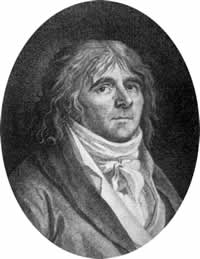 French ornithologist François Le Vaillant born in French Guiana, came to southern Africa in 1781 at the age of 28, after training as an ornithologist in Europe. His first expedition took him east as far as the Great Fish River, and he was in the area now around Somerset East and Cookhouse towards the end of 1781. He kept journals, but did not have an almanac, and was obviously a charming, eccentric, and dashing young man. He travelled with a large contingent in three oxwagons. His entourage included Kees, a baboon who served as food taster and companion, and a cock which was his alarm clock. He carried enough clothing and linen, he said, to allow him to change three times a day.
French ornithologist François Le Vaillant born in French Guiana, came to southern Africa in 1781 at the age of 28, after training as an ornithologist in Europe. His first expedition took him east as far as the Great Fish River, and he was in the area now around Somerset East and Cookhouse towards the end of 1781. He kept journals, but did not have an almanac, and was obviously a charming, eccentric, and dashing young man. He travelled with a large contingent in three oxwagons. His entourage included Kees, a baboon who served as food taster and companion, and a cock which was his alarm clock. He carried enough clothing and linen, he said, to allow him to change three times a day.
He collected 2 000 specimens of birds, and subsequently published the six volume Histoire Naturelle des Oiseaux d'Afrique between 1799 and 1808. Some of his specimens were later found to be fakes, made up of the parts of different birds, and he was discredited to a degree. In spite of this, his contribution to ornithology in Africa was immeasurable, and some of his specimens still exist in the museums of Europe.
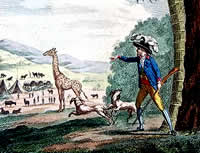 He wrote a highly dramatised account of his adventures which was translated into seven languages, and became the best seller of the time. One english translation, Le Vaillant's Travels into the Interior Parts of Africa was published in 1790. In 2008, the van Riebeeck Society re-translated the first half of this book and published it with many footnotes and extra information as FRANÇIOS LE VAILLANT Travels into the Interior of Africa via the Cape of Good Hope Volume 1.
He wrote a highly dramatised account of his adventures which was translated into seven languages, and became the best seller of the time. One english translation, Le Vaillant's Travels into the Interior Parts of Africa was published in 1790. In 2008, the van Riebeeck Society re-translated the first half of this book and published it with many footnotes and extra information as FRANÇIOS LE VAILLANT Travels into the Interior of Africa via the Cape of Good Hope Volume 1.
Levaillant's Cisticola is found in the area around Somerset East, and other birds still have the French names he attributed to them, including the Bateleur. He gave his Khoikhoi mistress the name Narina, the word for flower in her language, and he named the Narina Trogon for its beauty, which he compared with hers.
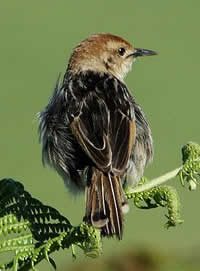 The following extracts are from the 1790 english translation of his book, and most of the events took place close to Bruintjies Hoogte, or the Klein Vis River.
The following extracts are from the 1790 english translation of his book, and most of the events took place close to Bruintjies Hoogte, or the Klein Vis River.
The following happened near Kokskraal, north of present day Cookhouse, where he camped for some time.
"Having observed the first afternoon some peroquets flying through the air in order to go and drink at the river, I watched them, and was lucky enough kill one of them. It was a new species, which has never yet been described; its size approaches that of the ash-coloured peroquet of Guineau; its general colour is a green of different shades, but the legs and the tip of the wings are a beautiful orange."
"I killed also several pretty birds; and among others a barbet, (in the footnote Bucco capensis Linn.) of a very small unknown species, and a cuckoo which I named the bawler (In French Criard), because its shrill cry may indeed be heard at a great distance; this cry, or, to express myself more correctly, this song, has no resemblance to that of our cuckoo in Europe, and its plumage also is entirely different. In this canton I found likewise a great many of the golden cuckoos described by Buffon under the name of the green-golden cuckoo of the 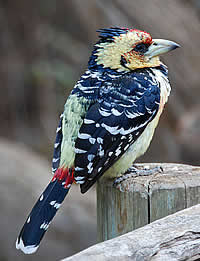 Cape. This bird is undoubtedly the most beautiful of its species, for its plumage is enriched with white, green, and gold. Perched on the tops of large trees, it continually repeats, and with varied modulation, these syllables, di, di, didric, as distinctly as I have written them; for this reason I have named it the didric."
Cape. This bird is undoubtedly the most beautiful of its species, for its plumage is enriched with white, green, and gold. Perched on the tops of large trees, it continually repeats, and with varied modulation, these syllables, di, di, didric, as distinctly as I have written them; for this reason I have named it the didric."
......"a bird perched near us which, instead of being frightened by our presence, approached more and more, sending forth very shrill cries. I was told that it was the bird which discovers honey; and I remarked in its gestures and cry a great affinity with those of the bird known to ornithologists under the name of cuculus indicator; but it was much larger than those which I had before seen. My Hottentots, who respect it on account of the services which it renders them, begged me to spare it. A new species, however, was to be added to my collection, and I killed it. This bird is of the genus of the common indicator, but larger, and different in its plumage; it is a variety of it. Naturalists, for what reason I know not, place the indicator among the cuckoos; it has no relation, however to this genus, but in the confirmation of its feet; and being different by other physical characters, it is much more so by its manner of living.....This bird is no more cuckoo that pies, barbets, perroquets, toucans, and all those species which have two toes before and two behind."
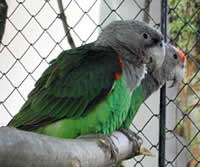 ........"In its stomach I found nothing but honey and wax: I did not observe the smallest portion of any insect. Its skin is thick, and so tough, that when it is fresh it can scarcely be penetrated by a pin. This is to me an instance of the wonderful precaution of nature, which having destined it to contend for its subsistence with the most ingenious of all insects, gave it a covering strong enough to defend it from their stings."
........"In its stomach I found nothing but honey and wax: I did not observe the smallest portion of any insect. Its skin is thick, and so tough, that when it is fresh it can scarcely be penetrated by a pin. This is to me an instance of the wonderful precaution of nature, which having destined it to contend for its subsistence with the most ingenious of all insects, gave it a covering strong enough to defend it from their stings."
"It builds itself a nest in hollow trees, climbs up to it in the same manner as the wood-pecker, and hatches its eggs itself. This circumstance is sufficient to separate it totally from the cuckoo, and to make it a new genus."
Regarding the naming of the red-chested cuckoo, or Piet-my-vrou, near Bruintjies Hoogte, Le Vaillant wrote - "These woods swarmed with touracos, which were more familiar, and appeared to be much larger than those of the forests of Auteniqua. I found here also a new species of calao; and, among other birds which I had never before seen, I distinguished a blackbird with an orange coloured belly; which, besides the pleasure occasioned by this discovery, gave me also an opportunity of remarking the simplicity of the Hottentots."
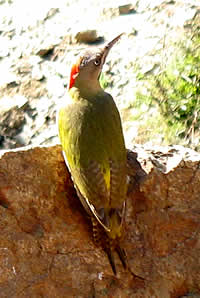 "Pit having brought me the bird, which was a female, I ordered him to return instantly to the spot where he had killed it, not doubting that he would find the male; but he begged me to dispense with his services upon this occasion, as he durst not venture to fire at it. I however continued to insist upon his obeying; but what was my astonishment when I saw him with an affected air, and in a tone almost lamentable, declare that some misfortune would undoubtedly ensue; that he had scarcely killed the female, when the male began to pursue him with great fury, continually repeating Pit-me-wrou, Pit-me-wrou! It must be observed that these two words exactly represent the animal's cry; and I was more convinced of this afterwards, by killing one of these blackbirds, than by the vain terrors of Pit. The syllables it seems to pronounce are three Dutch words, which signify Pit or Peter my wife; and Pit imagines that the bird, calling him by his name, requested him to return his mate."
"Pit having brought me the bird, which was a female, I ordered him to return instantly to the spot where he had killed it, not doubting that he would find the male; but he begged me to dispense with his services upon this occasion, as he durst not venture to fire at it. I however continued to insist upon his obeying; but what was my astonishment when I saw him with an affected air, and in a tone almost lamentable, declare that some misfortune would undoubtedly ensue; that he had scarcely killed the female, when the male began to pursue him with great fury, continually repeating Pit-me-wrou, Pit-me-wrou! It must be observed that these two words exactly represent the animal's cry; and I was more convinced of this afterwards, by killing one of these blackbirds, than by the vain terrors of Pit. The syllables it seems to pronounce are three Dutch words, which signify Pit or Peter my wife; and Pit imagines that the bird, calling him by his name, requested him to return his mate."
Although Le Vaillant admired the beauty of the touraco, or lourie, he found more mundane uses for them as well as collecting them as specimens! - "I killed likewise some flycatchers, and a great number of touraco, of which we made fricassees, much superior to those made of Guineau-hens or partridges with the same sauce."
......"Among other new birds of this canton, I shot a small eagle, which had a very long crest that hung down behind its head; and I named another bird the king's hunter (Martin chaffer) on account of the resemblance to that of the king's fisher. It's bill, which is long, is of a red colour; the back, the wings, and the tail, are a lively blue: it feeds upon insects, inhabits only the woods, and makes its nest in hollow trees. I shall not forget this beautiful bird in my ornithology."